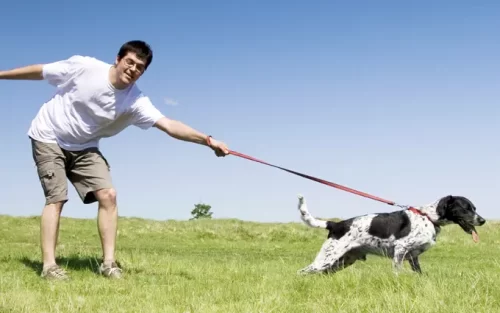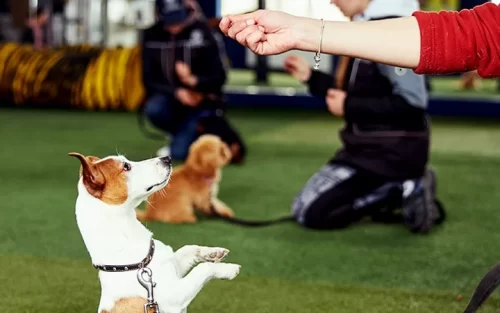Are you tired of your backyard looking like a minefield of holes? Does your dog seem to have a natural talent for landscaping? If you’re nodding along, then you’re in the right place! Digging is a natural behavior for dogs, but it can also be a frustrating one for owners. The good news is, with a little patience and consistency, you can teach your furry friend to keep their digging to a minimum.
First, it’s important to understand why dogs dig. There are a few reasons, including boredom, lack of exercise, anxiety, and the desire to escape or chase prey. Identifying the root cause can help you better address the behavior.
Next, you’ll want to explore some techniques for managing and training your dog. This includes creating a designated digging area, providing plenty of exercise and mental stimulation, using positive reinforcement training, and implementing deterrents like barriers or sprinklers.
In this article, we’ll dive deeper into the reasons why dogs dig and how you can modify their behavior. We’ll provide practical tips for creating a digging area, exercising your dog, and keeping them mentally stimulated. We’ll also discuss the importance of positive reinforcement training and how to implement it effectively. So, let’s get started on creating a happy and harmonious backyard for you and your furry friend!
Understanding Why Your Dog Digs
Have you ever wondered why your dog loves to dig in your backyard, leaving craters and holes everywhere? Digging is a natural and instinctual behavior for dogs, but it can also be a frustrating one for owners. In this article, we’ll explore why dogs dig and what you can do about it.
- Instinctual Behavior: Digging is an instinctual behavior for dogs. In the wild, dogs dig to create dens to protect themselves and their puppies from predators and harsh weather conditions. They also dig to hide food, such as bones or prey, for later consumption.
- Breed Characteristics: Some dog breeds are more prone to digging than others. For example, terrier breeds were originally bred to hunt small prey that live in underground burrows, so they have a strong instinct to dig. Hounds, such as beagles and basset hounds, were bred to track prey by scent, so they may dig to follow a scent trail. Working breeds, such as Siberian huskies and Alaskan malamutes, were bred for jobs like digging through snow and ice to create dens or tunnels, so they may be more prone to digging.
- Boredom and Lack of Exercise: Dogs that are bored or have excess energy may turn to digging as a way to release their pent-up energy. If your dog is not getting enough exercise, mental stimulation, or attention, they may turn to digging as a form of entertainment. A lack of exercise and stimulation can lead to a range of behavioral issues, including digging.
- Escape Artist :Some dogs may dig as a way to escape their yard or enclosure. If your dog is bored, anxious, or feels trapped, they may try to dig under or climb over a fence to escape. This can be dangerous, as it can put your dog at risk of getting hit by a car or getting lost.
- Comfort and Temperature Regulation: Digging can also be a way for dogs to cool down or warm up. In hot weather, dogs may dig a hole to lie in to escape the heat. In colder weather, they may dig a hole to curl up in for warmth.
- Anxiety and Stress: Dogs that are anxious or stressed may turn to digging as a way to cope. Separation anxiety, fear, and stress can all contribute to digging behavior. If your dog is exhibiting signs of anxiety, such as excessive barking, destructive behavior, or pacing, they may also be digging.
Now that you understand why your dog may be digging, it’s important to address the behavior to prevent it from becoming a problem. In the next section, we’ll explore some tips for stopping your dog from digging.
Preventing Digging Before It Starts
Dogs love to dig. Whether they’re burying a bone or trying to find a cool spot to lay down, digging is a natural behavior for dogs. However, it can also be a frustrating and destructive behavior for pet owners. Fortunately, there are steps you can take to prevent digging before it starts.
- Create a Digging Zone: One of the best ways to prevent digging is to give your dog an appropriate place to dig. You can create a digging zone in your yard by designating an area specifically for digging. You can use sand or soft dirt to make it more appealing. Encourage your dog to use this area by burying toys or treats for them to find.
- Keep Your Dog Occupied: A bored dog is more likely to dig. Provide your dog with plenty of toys and chew bones to keep them occupied. Puzzle toys and treat-dispensing toys can provide mental stimulation and keep your dog entertained for longer periods of time.
- Provide Adequate Exercise: Dogs that don’t get enough exercise are more likely to engage in destructive behaviors like digging. Make sure your dog is getting enough physical activity each day. Take them for regular walks and provide opportunities for them to run and play.
- Provide Shade: Dogs may dig to create a cool spot to lay down. If your dog spends a lot of time outside, make sure they have access to shade. This can help prevent them from digging to create a comfortable spot to lay down.
- Limit Access: If your dog has a tendency to dig in certain areas, consider limiting their access to those areas. You can use fencing or barriers to prevent your dog from accessing areas where they’re likely to dig.
- Use Positive Reinforcement: When your dog exhibits appropriate behavior, make sure to praise and reward them. Positive reinforcement can help encourage good behavior and prevent undesirable behavior like digging.
- Train Your Dog: Training your dog can help prevent digging by teaching them appropriate behaviors. Teach your dog basic commands like “sit” and “stay” and use positive reinforcement to encourage good behavior.
- Consider Professional Help: If your dog’s digging is causing damage to your property or is a persistent problem, consider seeking the help of a professional dog trainer. A trainer can work with you and your dog to address the behavior and develop a plan to prevent it.
By following these tips, you can prevent digging before it starts and enjoy a happy and healthy relationship with your dog. Remember to always use positive reinforcement and be patient with your furry friend. With a little effort and patience, you can help prevent digging and other undesirable behaviors in your dog.
Correcting Digging Behavior
If your dog has already started digging, there are several steps you can take to correct the behavior. It may take some time and patience, but with consistency, you can teach your dog that digging is not acceptable.
- Supervise and Redirect: The first step in correcting digging behavior is to supervise your dog when they are outside. This means keeping a close eye on them and redirecting their attention if they start to dig. Whenever you catch your dog digging, calmly say “no” or “leave it” and redirect their attention to a toy or activity that they enjoy.
- Create a Digging Zone: Sometimes, dogs simply enjoy digging, and it may be difficult to completely eliminate the behavior. In this case, you can create a designated digging zone in your yard. Choose an area away from your flower beds and garden, and fill it with soft, loose soil. Encourage your dog to dig in this area by hiding toys or treats in the soil.
- Provide Adequate Exercise and Mental Stimulation: Dogs may dig out of boredom or excess energy, so providing plenty of exercise and mental stimulation can help reduce the behavior. Make sure your dog is getting enough daily exercise, such as walks or playtime in the yard. Additionally, provide interactive toys and games that challenge their minds, such as puzzle toys or training sessions.
- Use Positive Reinforcement Training: Positive reinforcement training can be an effective tool in correcting digging behavior. When your dog is outside and not digging, offer praise and rewards, such as treats or playtime. This reinforces the behavior you want to see and encourages your dog to continue behaving well.
- Avoid Punishment: Punishing your dog for digging is not an effective way to correct the behavior. Not only does it create fear and stress in your dog, but it can also lead to more unwanted behaviors. Instead, focus on positive reinforcement training and redirection to encourage good behavior.
- Address Underlying Issues: Sometimes, digging can be a symptom of an underlying issue, such as separation anxiety or boredom. If you suspect your dog is digging out of anxiety or stress, consider working with a professional dog trainer or behaviorist to address the root cause of the behavior.
- Consider Fencing and Deterrents: If all else fails, consider installing a fence or using deterrents to prevent digging. A physical barrier can keep your dog from accessing certain areas of your yard, while deterrents such as citrus spray or motion-activated sprinklers can discourage digging behavior.
Correcting digging behavior in your dog takes patience, consistency, and positive reinforcement. By supervising your dog, providing exercise and mental stimulation, using positive reinforcement training, and addressing any underlying issues, you can teach your dog that digging is not acceptable. Remember to avoid punishment and consider using deterrents if needed. With time and effort, you can help your dog become a well-behaved and happy companion.
Dealing with Specific Digging Triggers
If you’ve already tried preventing and correcting your dog’s digging behavior but it continues to persist, it’s time to address specific digging triggers. Here are some common triggers and what you can do about them:
- Boredom: Dogs that are under-stimulated and lack sufficient exercise are more likely to dig. Make sure your dog is getting plenty of physical and mental exercise, such as daily walks, games of fetch, and training sessions.
- Separation anxiety: Dogs that suffer from separation anxiety may dig as a coping mechanism. If you suspect this is the case, work with a professional dog trainer or behaviorist to develop a plan to address your dog’s anxiety.
- Buried objects: Dogs may dig to uncover buried objects, such as bones or toys. Make sure to supervise your dog when they have access to these items, or simply remove them from the area altogether.
- Prey drive: Some dogs have a strong prey drive and may dig in an attempt to catch rodents or other small animals. If this is the case, work on training your dog to redirect their attention to more appropriate activities, such as playing fetch.
- Temperature regulation: In hot weather, dogs may dig to create a cool spot to lie down in. Provide plenty of shade and cool water for your dog to help prevent this behavior.
- Breed tendencies: Certain breeds, such as terriers and dachshunds, were originally bred for digging and may have a stronger urge to do so. If you have one of these breeds, consider providing a designated digging area, such as a sandbox or designated corner of the yard.
Remember that digging is a natural behavior for dogs, and it may be unrealistic to expect them to completely stop. However, by understanding and addressing specific triggers, you can minimize the behavior and redirect your dog’s attention to more appropriate activities.
Conclusion
Digging is a natural behavior for dogs, but it can become a problem if left unaddressed. Understanding the reasons why dogs dig, and taking steps to prevent and correct the behavior, can help keep your yard and garden safe and beautiful. Remember to always be patient and consistent in your training efforts, and never punish your dog for digging.
By following the tips outlined in this article, you can help prevent digging behavior before it starts, correct existing digging habits, and deal with specific digging triggers. It’s important to remember that each dog is unique, and what works for one may not work for another. Don’t be afraid to seek professional help if you’re struggling to address your dog’s digging behavior.



